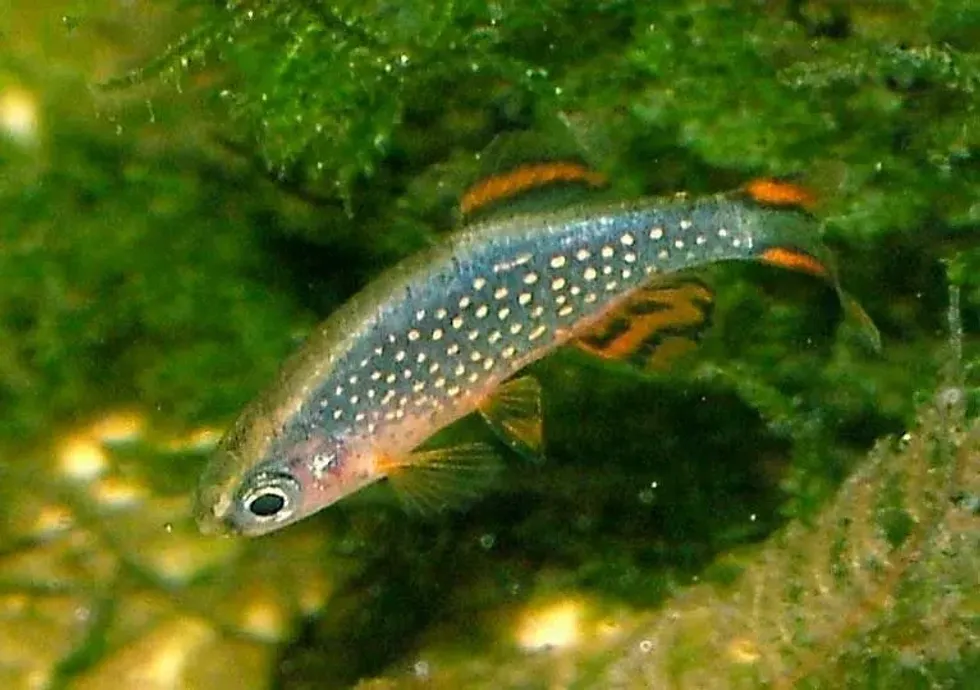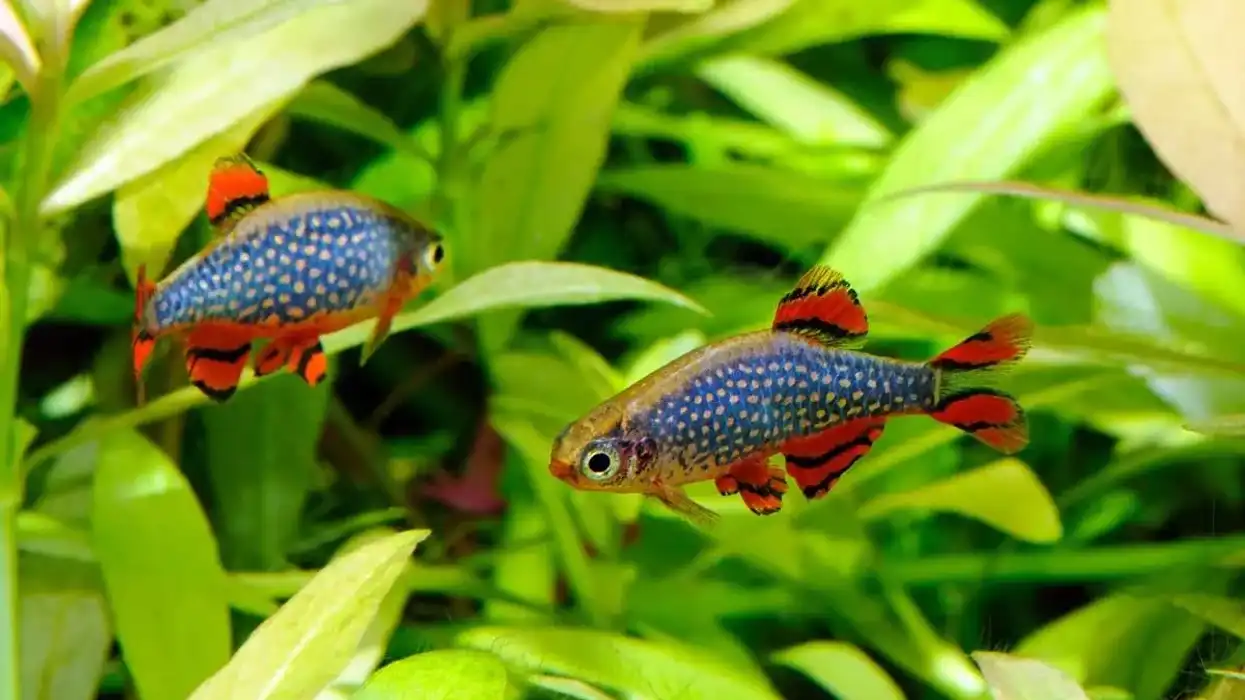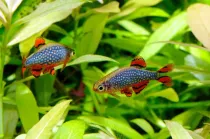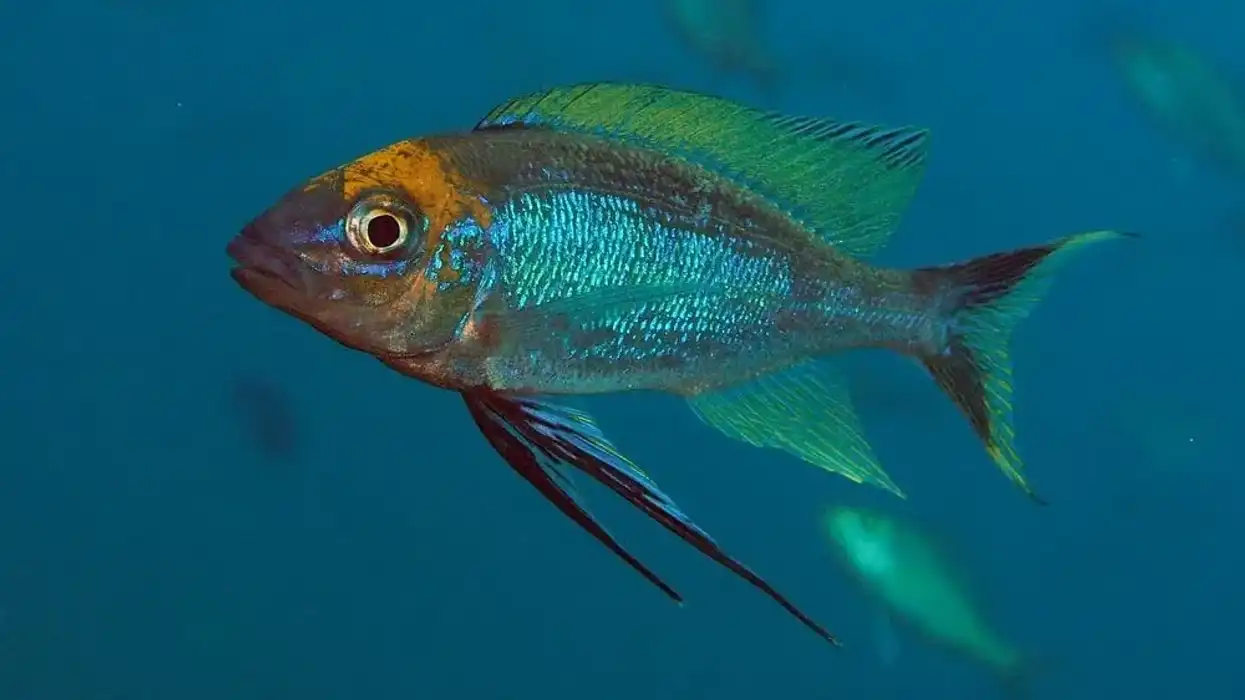Fun Pearl Danio Facts For Kids

Content
- What type of animal is a pearl danio?
- What class of animal does a pearl danio belong to?
- How many pearl danios are there in the world?
- Where does a pearl danio live?
- What is a pearl danios habitat?
- Who do pearl danios live with?
- How long does a pearl danio live?
- How do they reproduce?
- What is their conservation status?
- What do pearl danios look like?
- How cute are they?
- How do they communicate?
- How big is a pearl danio?
- How fast can a pearl danio swim?
- How much does a pearl danio weigh?
- What are the male and female names of the species?
- What would you call a baby pearl danio?
- What do they eat?
- Are they dangerous?
- Would they make a good pet?
- Did you know...
- Pearl danio breeding
- Getting your own pearl danio
Pearl danios are a species of peaceful tropical fish that belong to the minnow family called cyprinidae. They are originally from Myanmar, Sumatra, and Thailand and can be found in their natural habitats consisting of freshwater small ponds, tropical rivers and hill streams with generous water flow.
Pearl danios are also found in aquariums as they can be kept as tank mates along with other freshwater fish.
They grow up to a maximum size of 2.6 inches (6.5 cm) in length and can survive for five years give or take.
This species of freshwater fish usually has pink, brown-yellow, or silver bodies with two stripes of light yellow-white or blue-red and they have an iridescent look. Female pearl danios are distinguished by two pairs of barbels.
There are different varieties of popular pearl danios from this family of fish known as blue-red stripe danio and Kedah danio. They usually feed on zooplankton, exogenous insects, and baby brine shrimp.
Pearl danios are egglayers and can lay between 12 to 30 eggs at a time. If you want to know more about pearl danios, here is a list of some interesting and fun facts about this species of peaceful fish.
If you like reading our articles on animal facts, you can check out other amazing and engaging articles like chum salmon or convict cichlid.
Pearl Danio Interesting Facts
What type of animal is a pearl danio?
Pearl danios are a species of fish that belong to the minnow family of cyprinidae. Galaxy rasboras, or celestial pearl danios, also belong to this family.
What class of animal does a pearl danio belong to?
Pearl danios, or celestial pearl danios (Galaxy rasboras), belong to the class of actinopterygii. This is a class of fishes that are ray-finned and bony. Pearl danios are known to have these features.
How many pearl danios are there in the world?
It is impossible to know approximately how many pearl danios there are in the world, but their numbers have considerably dwindled because of their high demand. They are also bred in breeding tanks for commercial purposes, hence it is nearly impossible to know approximately how many pearl danios, or celestial pearl danios, are alive in the world.
Where does a pearl danio live?
Pearl danios are found in the shallow regions of tropical freshwater rivers and hill streams. Celestial pearl danios have a similar habitat as well but are found in a different region entirely.
What is a pearl danios habitat?
Pearl danios can only survive in ideal tropical water conditions with proper water parameters. They usually inhabit rivers, lakes, and streams with a generous flow of water with the temperature ranging from 68–77 °F (20–25 °C), pH levels between 6–8 pH, and water hardness of 5–19 dGH.
Who do pearl danios live with?
Pearl danios are quite peaceful and can live harmoniously with other benign fish in their natural habitat, as well as in a tank environment. They are well-adjusted and can live with small fish and other aquarium fish peacefully.
However, it is ideal to keep at least five pearl danios together if bought as pets. They also cannot survive with aggressive fish since they are not aggressive themselves.
How long does a pearl danio live?
Pearl danios and celestial pearl danios usually survive up to five years in both their natural habitat and aquarium environments if the water parameters are to their favor.
To help maintain pearl danios in an aquarium environment, make sure the aquarium mimics the tropical setting of the habitat they live in. The tanks need to be abundant with live plants and have good substrate filled with rocks to help protect their eggs from other hungry and predatory fish.
This, in turn, will help them thrive and live their full lives as they would in their own tropical aquatic environmental conditions.
How do they reproduce?
Pearl danios are a species of egg-laying fish and, like most other danios, the breeding pairs mate for life and are very loyal.
Pearl danios, including the celestial pearl danio, possess sexual dimorphism meaning that the females are more robust in comparison to the males. However, celestial pearl danio species does not have any particular spawning season, unlike pearl danios.
Females noticeably look slimmer after having spawned with the males and it is wise to remove the adults after the spawning process so that they do not consume their eggs.
Keep the tank water dark to help develop the eggs and inhibit fungal growth in the aquarium. The fry develop within 36 to 48 hours and to help them grow it is necessary to feed them micro foods such as infusoria, or live food such as freshly hatched brine shrimp.
Young pearl danios, or celestial pearl danios, can grow very fast within a week and should be raised on fine dry food or special fry food.
What is their conservation status?
Due to the high demand for pearl danios in the pet trade, they have considerably dwindled in number and have become quite rare.
Breeders and collectors are allowed to collect only a few dozen thereby increasing their price in the industry as well.
Due to their threatened numbers in the wild, the fishing industry has taken care not to catch too many of this species of fish from their own habitat, and have instead started to breed them in separate breeding tanks that cater to their needs and simulates the breeding season of pearl danios.
Their official status according to the IUCN is Near Threatened.
Pearl Danio Fun Facts
What do pearl danios look like?
Pearl danios are known to be one of the most attractive species of freshwater fish because of their iridescent colors. They have a distinctive pearly, pink, or blue-violet colored body that is accentuated by a stripe of red or orange that runs from their tail to the middle of their body.
This species of fish are characterized by their sexual dimorphism as females are more robust than male pearl danios. Males are usually smaller, thinner, and more vibrant.
They often possess a bright red-tinted stripe running along their ventral fin. Their dorsal fin has around seven soft rays in total and their anal fin has between 12 and 13 soft rays. However, females seem to look thinner after spawning with their mate.
This is how pet owners and breeders can determine if they are pregnant or not. They make an outstanding addition to any community tank or an aquarium.

How cute are they?
Pearl danios are exceptionally cute and attractive to look at hence leading to their popularity as pets. Their bright vibrant colors are what make them stand out the most and they make great accents in an aquarium along with other peaceful freshwater fish.
How do they communicate?
Pearl danios are peaceful species of fish and are not known to cause much harm to other fishes around them.
Pearl danios mate for life, and unlike the species of common pearl danios, celestial pearl danios have no particular mating season. It is during the mating season that males are seen communicating with females while courting them, they do this by swimming in pursuit behind them.
They can also follow a mated pair to fertilize their eggs which they then deposit in substrate inside the water of their habitat or aquarium.
How big is a pearl danio?
Pearl danios sizes can usually range between 1.3-2.5 in (3.4-6.5 cm). Females are usually larger and more robust than males and this is what sets them apart in their habitat and the aquarium. It is because of their petite size and bright color that their popularity as attractive aquarium fishes has risen.
How fast can a pearl danio swim?
It is unknown how fast pearl danio fishes can swim. However, they usually inhabit fast-flowing freshwater rivers, lakes and streams which makes them quite nimble when it comes to swimming.
How much does a pearl danio weigh?
An average pearl danio fish, that has reached its full size, usually weighs up to 0.2 lb (3.5 oz). The tiny and petite size of this fish species makes them lightweight. This is another reason for their popularity as tank fishes.
What are the male and female names of the species?
The male and female pearl danio fishes do not have any distinguishing names to tell them apart. They are only determined by their size.
Pearl danio is a species of fish that are known to possess sexual dimorphism, this means that the females of this fish species are significantly larger and more robust. However, they get slimmer after having spawned with their mates.
What would you call a baby pearl danio?
Baby pearl danios are usually called fry or infants and they are not given any particular name to distinguish them. The fry usually hatches within 36 to 48 hours after the mated pair have finished spawning.
Breeding pearl danio fry is easy and effortless, but they need to be kept in a separate aquarium and fed live food. Brine shrimp that are newly hatched is one of the best foods to feed pearl danio fry to help them develop.
What do they eat?
Pearl danios, in their natural habitat, primarily feed on zooplankton and insects. However, pet pearl danios should be given good quality granulated food or tropical flakes to maintain their health. Frozen food as well as live foods like mosquito larvae, tubifex, daphnia or brine shrimp are also part of their diet.
Are they dangerous?
Pearl danio fish are known to not only be an attractive species of fish, but they are also very benign and peaceful. This species of fish does not bring harm to other fish and they swim silently, going about their own business.
However, zebra pearl danios are known to attack each other and can cause fin rot in their victims. They should not be kept in huge groups in a tank, and an equal number of males and females in the tank is imperative.
Would they make a good pet?
Pearl danios make exceptional pets because of how beautiful and petite they are.
As they come in various vibrant and bright colors, they are all the more popular because they add beauty to any tank. This species of fish is so widely bred and caught that they are slowly dwindling in numbers, hence breeders and sellers are being extremely careful.
If you want to keep pearl danios as pets, make sure that tank you put them in is very large, the water conditions should be optimized to ensure their safety and well-being.
In order to survive, they require a tropical climate, ideal water conditions and generous water flow. The water temperature has to range from 68–77 °F (20–25 °C), the water pH levels should be 6–8 pH, with a water of hardness of 5–19 dGH.
Pearl danio fish can swim up to the surface of the water of their tank if there is a lack of oxygen, most fish can be seen gasping for air when they are near the surface which is a clear sign of distress.
Did you know...
One of the most famous species of the danio family is celestial pearl danios, scientifically known as Celestichthys margaritatus, but these fishes should not be mistaken for pearl danios as they have quite different features. In the aquarium trade, they are more popularly known as galaxy rasboras.
Celestial pearl danios, or galaxy rasbora, which were first discovered in 2006, are only known to be found in a limited area close to the Hopong side of Inle lake.
Celestial pearl danios, or galaxy rasboras, are highly popular in the pet market because of their small and petite size as well as their bright colors. They are not aggressive at all and can adjust well with other aquarium fish.
Pearl danio breeding
Pearl danios are very easy and effortless to breed as long as they are kept in good water conditions. In the pet industry they are bred prolifically in order to sell them to willing customers and consumers.
To breed this species of fish, you should have a specific breeding tank.
Since pearl danio fishes inhabit the shallow areas of freshwater lakes, it would be helpful to keep the water level shallow and add some fine-leaved aquatic plants to mimic the tropical environment of their habitat.
Adding marbles to the bottom is an excellent idea for a substrate that can help keep stray eggs hidden from hungry adult fish, introducing a breeding grid or mop will also keep the eggs protected at the bottom of the tank. Pearl danios are usually bred as pairs or in a school.
There should be an equal number of females and males in the breeding tank. However, females should be added to the tank a few days before including the males to help them form pairs.
Adding a little bit of cold water from time to time also helps to initiate the spawning process as it simulates the rainy season of their habitat.
Pairs usually spawn the following morning. However, for celestial pearl danios, the temperature of the water in the aquarium is not integral to their mating process because they do not have any particular mating season.
Females noticeably look slimmer after having spawned with the males and it is wise to remove the adults after the spawning process so that they do not consume their eggs. Keep the tank water dark to help develop the eggs and inhibit fungal growth in the aquarium.
The fry usually hatches within 36 to 48 hours.
In order to help them grow, you should feed them some micro foods like infusoria or live food like freshly hatched brine shrimp. Young pearl danios, or celestial pearl danios, can grow very fast within a week and should be raised on fine dry food or special fry food.
Getting your own pearl danio
Celestial pearl danios and common pearl danios are quite popular as pets and should always be bought from a trusted pet trader or fish breeder. It is imperative to buy a couple of them and the group should have an equal pair of males and females if you are planning to breed them as well.
They should be kept in a tank with ideal water conditions and filled with fine-leaved aquatic plants.
Here at Kidadl, we have carefully created lots of interesting family-friendly animal facts for everyone to discover! Learn more about some other fish including flagfish, or stonefish.
You can even occupy yourself at home by drawing one of our pearl danio coloring pages.
We Want Your Photos!
More for You
See All
Bachelor of Arts specializing in Journalism and Mass Communication, Postgraduate Diploma in Sports Management

Moumita DuttaBachelor of Arts specializing in Journalism and Mass Communication, Postgraduate Diploma in Sports Management
A content writer and editor with a passion for sports, Moumita has honed her skills in producing compelling match reports and stories about sporting heroes. She holds a degree in Journalism and Mass Communication from the Indian Institute of Social Welfare and Business Management, Calcutta University, alongside a postgraduate diploma in Sports Management.
Bachelor of Law

Abdulqudus MojeedBachelor of Law
A versatile professional with a passion for creative writing and technology. Abdulqudus is currently pursuing his Bachelor of Law from the University of Lagos and has experience as a tutor, intern assistant, and volunteer. He possesses strong organizational skills and is a detail-oriented person.
Disclaimer
1) Kidadl is independent and to make our service free to you the reader we are supported by advertising. We hope you love our recommendations for products and services! What we suggest is selected independently by the Kidadl team. If you purchase using the Buy Now button we may earn a small commission. This does not influence our choices. Prices are correct and items are available at the time the article was published but we cannot guarantee that on the time of reading. Please note that Kidadl is a participant in the Amazon Services LLC Associates Program, an affiliate advertising program designed to provide a means for sites to earn advertising fees by advertising and linking to Amazon. We also link to other websites, but are not responsible for their content.
2) At Kidadl, we strive to recommend the very best activities and events. We will always aim to give you accurate information at the date of publication - however, information does change, so it’s important you do your own research, double-check and make the decision that is right for your family. We recognise that not all activities and ideas are appropriate for all children and families or in all circumstances. Our recommended activities are based on age but these are a guide. We recommend that these ideas are used as inspiration, that ideas are undertaken with appropriate adult supervision, and that each adult uses their own discretion and knowledge of their children to consider the safety and suitability. Kidadl cannot accept liability for the execution of these ideas, and parental supervision is advised at all times, as safety is paramount. Anyone using the information provided by Kidadl does so at their own risk and we can not accept liability if things go wrong.
3) Because we are an educational resource, we have quotes and facts about a range of historical and modern figures. We do not endorse the actions of or rhetoric of all the people included in these collections, but we think they are important for growing minds to learn about under the guidance of parents or guardians.







